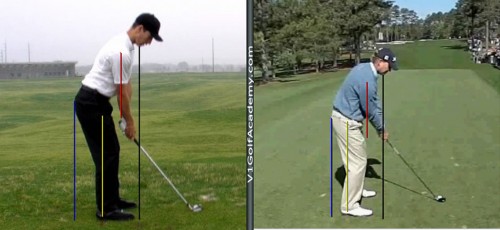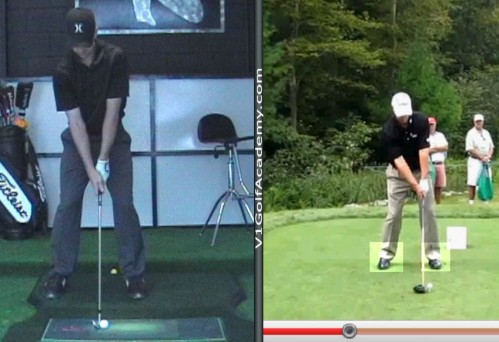Steve Stricker’s ascent to the 3rd in the Official World Golf Rankings is an inspirational story to all of us in the golfing world who are striving to improve our games. Stricker joined the PGA Tour back in 1994 and achieved early success in his fledgling career. In 1996, he won two tournaments and compiled 7 top ten finishes. He finished the year 4th on the PGA Tour money list and appeared poised for greatness. As quite often happens in this fickle game, Stricker had nothing but lean times to follow, however, as he would proceed to struggle mightily and eventually lose his card in 2004. Determined to rededicate himself to resurrecting his career, Steve persevered, and tirelessly worked at retooling his swing. Relying solely on sponsor’s exemptions in 2006, Stricker managed 7 top ten finishes and was voted PGA Tour Comeback Player of the Year. I can speak from personal experience in stating that his story is proof nice guys don’t have to finish last. I had the pleasure of talking with him on the practice tee at Westchester Country Club in 2007, several days before his fantastic victory at The Barclay’s, the first leg of the inaugural Fed Ex Cup Playoffs. He is a soft spoken, humble man and undoubtedly one of the nicest professional golfers I have had the good fortune to meet in my career.
Stricker’s golf swing has certainly been the buzz throughout the major golf media these days, and many have analyzed his swing attempting to explain his second coming. This is the perfect opportunity for us to examine Stricker’s fundamentals and discuss in greater detail how he measures up to the Rotary Swing Model. We will be breaking down Steve’s swing into five parts: Setup, Move 1, Move 2, Move 3, and Move 4.
Setup
We shall first examine Stricker from a down the line view. In this image, it appears Stricker is hitting a hybrid club on what we can assume to be a short par 4. We have talked at great length about the importance of a proper Setup and how the goal for the Setup is to ensure that our bodies are anchored to the ground in such a way that will provide a stable, centered engine for our golf swing, and that the proper muscles are engaged for correct posture, stability, and power. As we examine Stricker at address, it becomes quite clear that a number of improvements could be employed.

1. Improper Hinge from the Hips.
Chuck Quinton and Alison Thietje have gone to great lengths to describe in detail how the body is designed to function. Rotary Swing commonly refers to these fundamentals as the anatomical absolutes. These are not opinions or preferences but are facts about the design of the human body. One of these anatomical absolutes is that the body is designed to bear its weight directly over the ankle joint in order to be balanced. We want to accomplish the same when setting up to a golf ball. Stricker’s weight is not properly distributed at address. He displays an improper hinge from the hips, which causes his upper torso to be positioned very upright. This can be observed by the blue line drawn from his posterior to the ground. The lack of space from this line to the back of his heels indicates more hinge is necessary. Proper hinging from the hips ensures that we will not introduce any excessive curvature of the spine during Setup. This brings us to our next area of contention.
2. Rounded Shoulders (Excessive Curvature of the Thoracic Spine)
We want the spine to remain in neutral joint alignment throughout the entire golf swing for obvious health and safety reasons. Stricker, because of the improper hinge from the hips, has now allowed his thoracic spine to slump or round. The result of this excessive thoracic bending is becoming disconnected from the core muscles of the body. Stricker has effectively gotten out of “the box,” put himself into “the rectangle.” The effects of this will be very eloquently illustrated when we examine Stricker’s Move 1 in the next installment.
3. Extended Arms
The arms should remain tension free at Setup. When this is performed correctly, the shoulder and elbow will be in neutral joint alignment. The arms should hang naturally underneath the shoulders with the elbows directly beneath the shoulders. The hands will hang naturally underneath the chin. In Stricker’s case, improper hinge from the hips and the rounding of the shoulders have put him into a position of extending his arms, which can be observed by the red and black lines. The extended arms and disconnection from the core will greatly affect Stricker’s origin of movement as he starts his swing.
4. Excessive Knee Flex
Stricker displays an excessive flexion of the knees. This can plainly be observed by the yellow line drawn up through the center of the ankle joint. The back of the knee joint should rest on this line, but it is quite evident that this is not the case. The body is designed to bear its weight over the center of the ankle joint in order to be balanced. We want to accomplish much the same when setting up to the golf ball. Excessive knee flex forces the weight of the body to be positioned over the balls of the feet which does not allow for the effective use of the body’s anatomical design. Once again, this element of Stricker’s Setup leads to some balance issues that become more clearly defined in his backswing.
5. Ankles Not Properly Rolled Inward
Looking at the face on view of Stricker now, he has failed to roll his ankles in slightly which has been highlighted. This important Setup feature serves to stabilize lateral hip movement in addition to ensuring that the right foot does not roll outward as we load into the right side on the backswing. This action makes a proper weight shift in the downswing more difficult to perform with maximum efficiency.
In summary, Stricker’s combination of Setup flaws does not put him in an anatomically correct address position. His main faults are the following: he is effectively disengaged from his core, and his weight is on the balls of his feet. These faults and their effects will become more apparent as he starts his backswing and will be covered in great detail in the next installment, Steve Stricker: Move 1(The Takeaway).
















